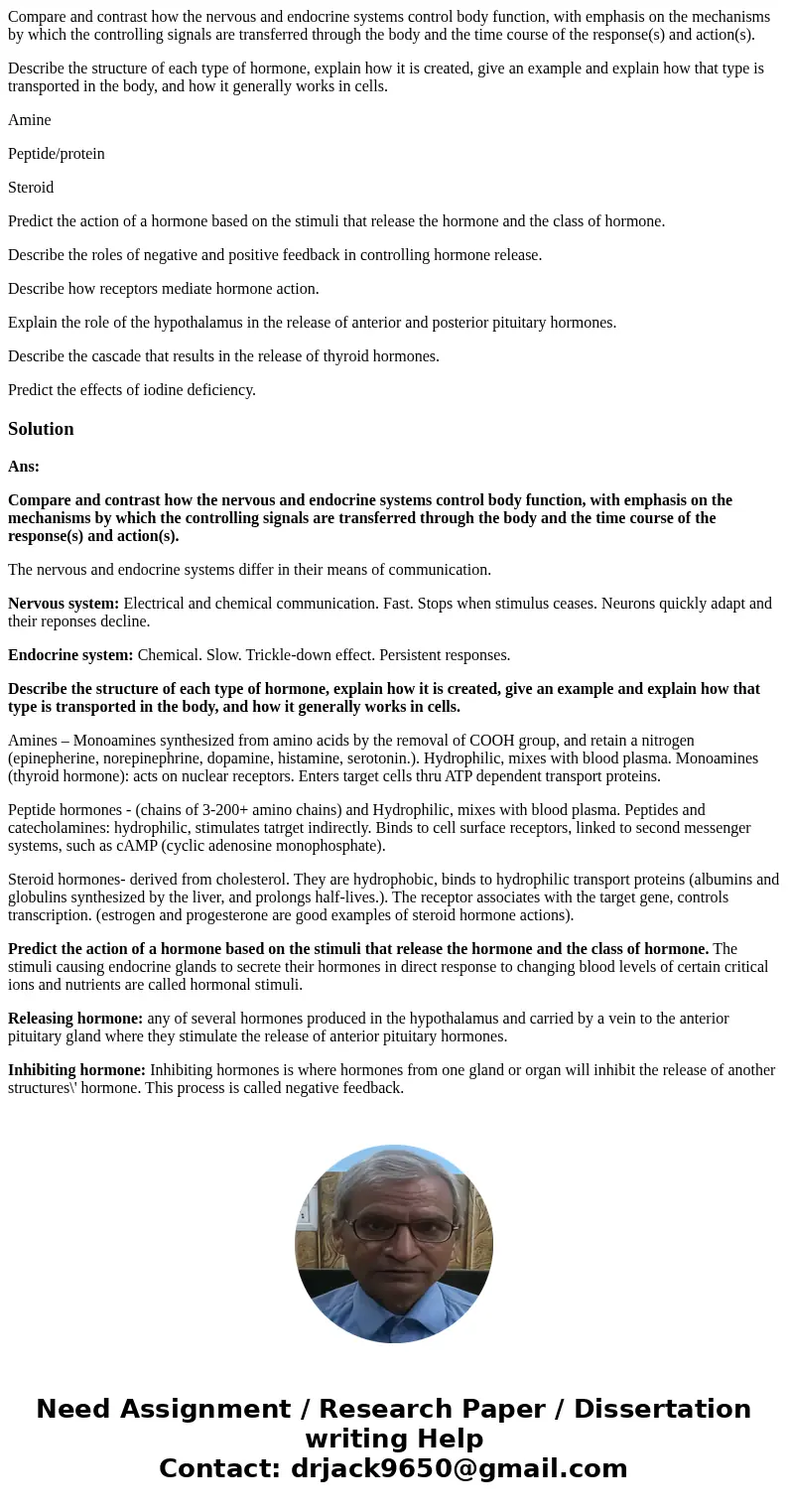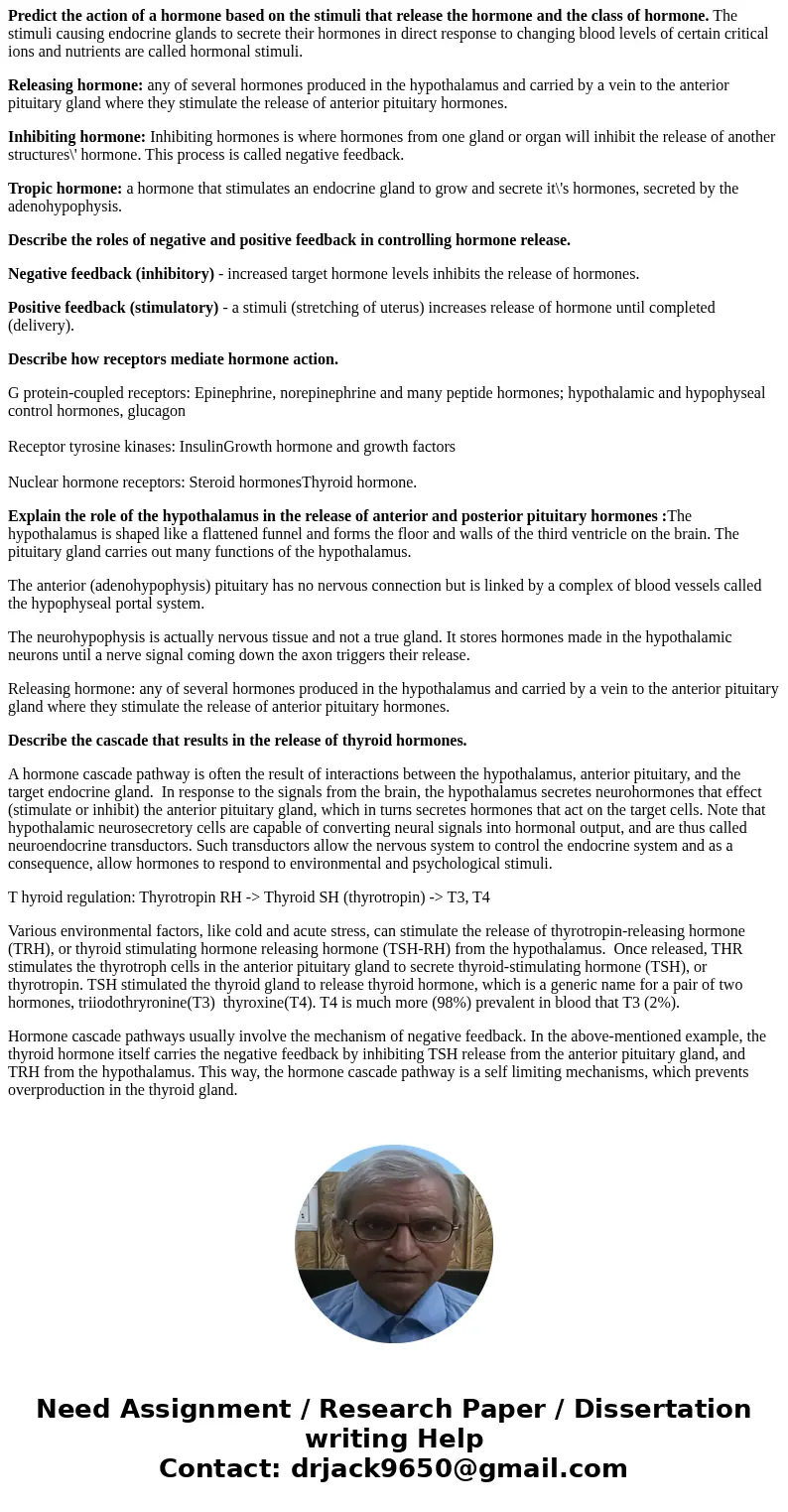Compare and contrast how the nervous and endocrine systems c
Compare and contrast how the nervous and endocrine systems control body function, with emphasis on the mechanisms by which the controlling signals are transferred through the body and the time course of the response(s) and action(s).
Describe the structure of each type of hormone, explain how it is created, give an example and explain how that type is transported in the body, and how it generally works in cells.
Amine
Peptide/protein
Steroid
Predict the action of a hormone based on the stimuli that release the hormone and the class of hormone.
Describe the roles of negative and positive feedback in controlling hormone release.
Describe how receptors mediate hormone action.
Explain the role of the hypothalamus in the release of anterior and posterior pituitary hormones.
Describe the cascade that results in the release of thyroid hormones.
Predict the effects of iodine deficiency.
Solution
Ans:
Compare and contrast how the nervous and endocrine systems control body function, with emphasis on the mechanisms by which the controlling signals are transferred through the body and the time course of the response(s) and action(s).
The nervous and endocrine systems differ in their means of communication.
Nervous system: Electrical and chemical communication. Fast. Stops when stimulus ceases. Neurons quickly adapt and their reponses decline.
Endocrine system: Chemical. Slow. Trickle-down effect. Persistent responses.
Describe the structure of each type of hormone, explain how it is created, give an example and explain how that type is transported in the body, and how it generally works in cells.
Amines – Monoamines synthesized from amino acids by the removal of COOH group, and retain a nitrogen (epinepherine, norepinephrine, dopamine, histamine, serotonin.). Hydrophilic, mixes with blood plasma. Monoamines (thyroid hormone): acts on nuclear receptors. Enters target cells thru ATP dependent transport proteins.
Peptide hormones - (chains of 3-200+ amino chains) and Hydrophilic, mixes with blood plasma. Peptides and catecholamines: hydrophilic, stimulates tatrget indirectly. Binds to cell surface receptors, linked to second messenger systems, such as cAMP (cyclic adenosine monophosphate).
Steroid hormones- derived from cholesterol. They are hydrophobic, binds to hydrophilic transport proteins (albumins and globulins synthesized by the liver, and prolongs half-lives.). The receptor associates with the target gene, controls transcription. (estrogen and progesterone are good examples of steroid hormone actions).
Predict the action of a hormone based on the stimuli that release the hormone and the class of hormone. The stimuli causing endocrine glands to secrete their hormones in direct response to changing blood levels of certain critical ions and nutrients are called hormonal stimuli.
Releasing hormone: any of several hormones produced in the hypothalamus and carried by a vein to the anterior pituitary gland where they stimulate the release of anterior pituitary hormones.
Inhibiting hormone: Inhibiting hormones is where hormones from one gland or organ will inhibit the release of another structures\' hormone. This process is called negative feedback.
Tropic hormone: a hormone that stimulates an endocrine gland to grow and secrete it\'s hormones, secreted by the adenohypophysis.
Describe the roles of negative and positive feedback in controlling hormone release.
Negative feedback (inhibitory) - increased target hormone levels inhibits the release of hormones.
Positive feedback (stimulatory) - a stimuli (stretching of uterus) increases release of hormone until completed (delivery).
Describe how receptors mediate hormone action.
G protein-coupled receptors: Epinephrine, norepinephrine and many peptide hormones; hypothalamic and hypophyseal control hormones, glucagon
Receptor tyrosine kinases: InsulinGrowth hormone and growth factors
Nuclear hormone receptors: Steroid hormonesThyroid hormone.
Explain the role of the hypothalamus in the release of anterior and posterior pituitary hormones :The hypothalamus is shaped like a flattened funnel and forms the floor and walls of the third ventricle on the brain. The pituitary gland carries out many functions of the hypothalamus.
The anterior (adenohypophysis) pituitary has no nervous connection but is linked by a complex of blood vessels called the hypophyseal portal system.
The neurohypophysis is actually nervous tissue and not a true gland. It stores hormones made in the hypothalamic neurons until a nerve signal coming down the axon triggers their release.
Releasing hormone: any of several hormones produced in the hypothalamus and carried by a vein to the anterior pituitary gland where they stimulate the release of anterior pituitary hormones.
Describe the cascade that results in the release of thyroid hormones.
A hormone cascade pathway is often the result of interactions between the hypothalamus, anterior pituitary, and the target endocrine gland. In response to the signals from the brain, the hypothalamus secretes neurohormones that effect (stimulate or inhibit) the anterior pituitary gland, which in turns secretes hormones that act on the target cells. Note that hypothalamic neurosecretory cells are capable of converting neural signals into hormonal output, and are thus called neuroendocrine transductors. Such transductors allow the nervous system to control the endocrine system and as a consequence, allow hormones to respond to environmental and psychological stimuli.
T hyroid regulation: Thyrotropin RH -> Thyroid SH (thyrotropin) -> T3, T4
Various environmental factors, like cold and acute stress, can stimulate the release of thyrotropin-releasing hormone (TRH), or thyroid stimulating hormone releasing hormone (TSH-RH) from the hypothalamus. Once released, THR stimulates the thyrotroph cells in the anterior pituitary gland to secrete thyroid-stimulating hormone (TSH), or thyrotropin. TSH stimulated the thyroid gland to release thyroid hormone, which is a generic name for a pair of two hormones, triiodothryronine(T3) thyroxine(T4). T4 is much more (98%) prevalent in blood that T3 (2%).
Hormone cascade pathways usually involve the mechanism of negative feedback. In the above-mentioned example, the thyroid hormone itself carries the negative feedback by inhibiting TSH release from the anterior pituitary gland, and TRH from the hypothalamus. This way, the hormone cascade pathway is a self limiting mechanisms, which prevents overproduction in the thyroid gland.


 Homework Sourse
Homework Sourse